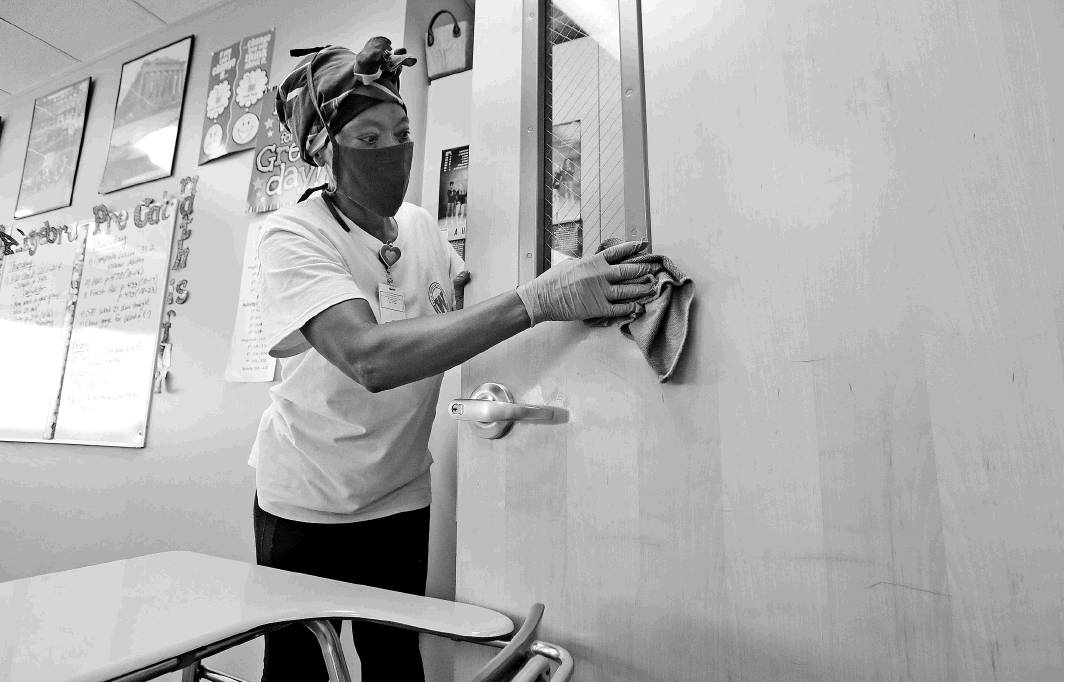Reopening schools safely will be costly
Geoff MulvihillASSOCIATED PRESS
As school districts across the country decide how and when they can bring students back to campus safely, a major sticking point is emerging: the money to make it happen.
Keeping public schools for 50 million students and more than 7 million employees safe from the coronavirus could require more teachers, substitutes, nurses and custodians. School districts will need to find more buses to allow for more space between children, and to buy more computers for distance learning. They’ll need to buy sanitizer, masks and other protective equipment. Some are putting up plastic dividers in offices and classrooms.
While public-health concerns are getting most of the attention, especially with the nation’s infections and hospitalizations rising, costs have become a major consideration. Many districts hope that Congress will step in.
The Council of Chief State School Officers says that safely reopening public schools could cost between $158 billion and $245 billion, while the American Federation of Teachers put the figure at $116.5 billion. The Association of School Business Officials International estimates that reopening will require additional spending equivalent to about 3.5% of districts’ normal budgets.
“If you don’t have this money, how are you going to afford PPE? How are you going to have cleaning every day?” asked Randi Weingarten, president of the American Federation of Teachers. “That’s why you’re going to see more and more districts, even when they don’t have surges, staying with remote learning.”
School officials in Los Angeles and San Diego, the two largest districts in California, said last week that they will begin their year with only online classes. Many other districts, including New York City, plan to have each student attend class in person on only some days while doing work online the rest of the time.
Columbus City Schools expects to bring back younger students in shifts while having high schoolers take all their classes online. But district spokesman Scott Wortman said those plans are not certain, and the ability to pay for measures needed to safely reopen will play a role in the final decision.
The district estimates its reopening costs at $100 million — nearly four times the previously approved federal funding that it expects to get.
Virginia Department of Education spokesman Charles B. Pyle said school districts there will need more than the $282 million the state received in the previous congressional relief bill to safely reopen “and respond to the spikes that will inevitably occur during the year.”
Coronavirus aid will be the highest-profile item on the agenda when Congress returns this week, including how much money to make available for schools.
Senate Majority Leader Mitch Mc-Connell, R-Ky., has scoffed at the $3 trillion overall aid package that Democrats are calling for, but he has said that funding education will be a priority.
President Donald Trump has said in recent weeks that schools that don’t reopen for full, in-person classes could see federal money reduced.
Congress has approved more than $3 trillion in aid to address the corona-virus outbreak and economic fallout. That includes $150 billion for states, territories, large local governments and Native American tribes, plus more than $13 billion directed specifically to education.
On conference calls with governors and in a briefing this month, Vice President Mike Pence has been critical of states because only a small portion of the $13 billion — 1.5% as of last week — had been spent. Chip Slaven, the chief advocacy officer for the National School Boards Association, said slow spending of that money should not keep Congress from providing more money to make schools safe for reopening. Districts are still trying to figure out how they can spend the money in accordance with guidelines set by U.S. Department of Education, he said.
Slaven said the federal government should send at least $200 billion to state education departments and school districts. That’s in line with what the Council of Chief State School Officers has called for.
“The whole point of the federal government is — when there’s a national emergency like this — is to step up to the plate with a plan, with resources and with help,” he said.
For schools in many states, high reopening costs are only one side of the coin. State tax collections plunged when much of the economy was shut in the spring. That had a trickle-down effect on school funding, typically the largest part of a state budget.
The Sioux Falls School District, the largest in South Dakota, estimates that it will need $7.8 million for protective equipment, cleaning supplies, high-powered filters for ventilation systems and other items to make it safer to reopen school buildings. The district plans to use $4.1 million from earlier federal funding and is applying for other grants.
At the same time, the district has slashed $1.3 million from its regular budget to prepare for possible funding cuts from the state. District business manager Todd Vik said administrators canceled plans for building expansions and hiring 15 teachers, and reduced planned salary increases.
“While we’re looking at cutting on one hand,” he said, “we’re looking at responding to the coronavirus and increasing spending in other areas.”
